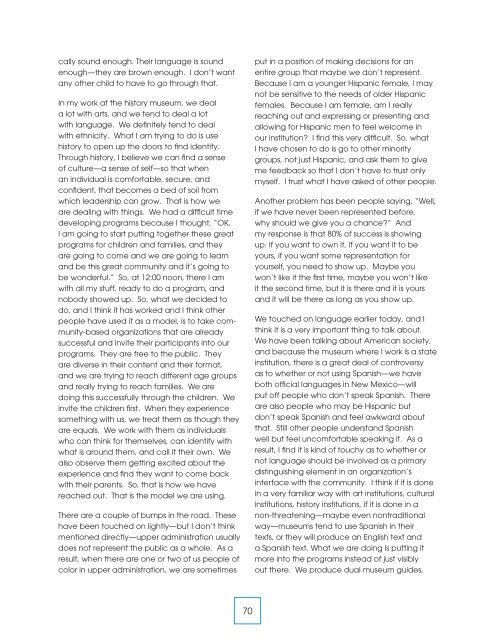The New Face of Arts Leadership in the West - westaf - The Western ...
The New Face of Arts Leadership in the West - westaf - The Western ...
The New Face of Arts Leadership in the West - westaf - The Western ...
Create successful ePaper yourself
Turn your PDF publications into a flip-book with our unique Google optimized e-Paper software.
cally sound enough. <strong>The</strong>ir language is sound<br />
enough—<strong>the</strong>y are brown enough. I don’t want<br />
any o<strong>the</strong>r child to have to go through that.<br />
In my work at <strong>the</strong> history museum, we deal<br />
a lot with arts, and we tend to deal a lot<br />
with language. We def<strong>in</strong>itely tend to deal<br />
with ethnicity. What I am try<strong>in</strong>g to do is use<br />
history to open up <strong>the</strong> doors to f<strong>in</strong>d identity.<br />
Through history, I believe we can f<strong>in</strong>d a sense<br />
<strong>of</strong> culture—a sense <strong>of</strong> self—so that when<br />
an <strong>in</strong>dividual is comfortable, secure, and<br />
confident, that becomes a bed <strong>of</strong> soil from<br />
which leadership can grow. That is how we<br />
are deal<strong>in</strong>g with th<strong>in</strong>gs. We had a difficult time<br />
develop<strong>in</strong>g programs because I thought, “OK,<br />
I am go<strong>in</strong>g to start putt<strong>in</strong>g toge<strong>the</strong>r <strong>the</strong>se great<br />
programs for children and families, and <strong>the</strong>y<br />
are go<strong>in</strong>g to come and we are go<strong>in</strong>g to learn<br />
and be this great community and it’s go<strong>in</strong>g to<br />
be wonderful.” So, at 12:00 noon, <strong>the</strong>re I am<br />
with all my stuff, ready to do a program, and<br />
nobody showed up. So, what we decided to<br />
do, and I th<strong>in</strong>k it has worked and I th<strong>in</strong>k o<strong>the</strong>r<br />
people have used it as a model, is to take community-based<br />
organizations that are already<br />
successful and <strong>in</strong>vite <strong>the</strong>ir participants <strong>in</strong>to our<br />
programs. <strong>The</strong>y are free to <strong>the</strong> public. <strong>The</strong>y<br />
are diverse <strong>in</strong> <strong>the</strong>ir content and <strong>the</strong>ir format,<br />
and we are try<strong>in</strong>g to reach different age groups<br />
and really try<strong>in</strong>g to reach families. We are<br />
do<strong>in</strong>g this successfully through <strong>the</strong> children. We<br />
<strong>in</strong>vite <strong>the</strong> children first. When <strong>the</strong>y experience<br />
someth<strong>in</strong>g with us, we treat <strong>the</strong>m as though <strong>the</strong>y<br />
are equals. We work with <strong>the</strong>m as <strong>in</strong>dividuals<br />
who can th<strong>in</strong>k for <strong>the</strong>mselves, can identify with<br />
what is around <strong>the</strong>m, and call it <strong>the</strong>ir own. We<br />
also observe <strong>the</strong>m gett<strong>in</strong>g excited about <strong>the</strong><br />
experience and f<strong>in</strong>d <strong>the</strong>y want to come back<br />
with <strong>the</strong>ir parents. So, that is how we have<br />
reached out. That is <strong>the</strong> model we are us<strong>in</strong>g.<br />
<strong>The</strong>re are a couple <strong>of</strong> bumps <strong>in</strong> <strong>the</strong> road. <strong>The</strong>se<br />
have been touched on lightly—but I don’t th<strong>in</strong>k<br />
mentioned directly—upper adm<strong>in</strong>istration usually<br />
does not represent <strong>the</strong> public as a whole. As a<br />
result, when <strong>the</strong>re are one or two <strong>of</strong> us people <strong>of</strong><br />
color <strong>in</strong> upper adm<strong>in</strong>istration, we are sometimes<br />
put <strong>in</strong> a position <strong>of</strong> mak<strong>in</strong>g decisions for an<br />
entire group that maybe we don’t represent.<br />
Because I am a younger Hispanic female, I may<br />
not be sensitive to <strong>the</strong> needs <strong>of</strong> older Hispanic<br />
females. Because I am female, am I really<br />
reach<strong>in</strong>g out and express<strong>in</strong>g or present<strong>in</strong>g and<br />
allow<strong>in</strong>g for Hispanic men to feel welcome <strong>in</strong><br />
our <strong>in</strong>stitution? I f<strong>in</strong>d this very difficult. So, what<br />
I have chosen to do is go to o<strong>the</strong>r m<strong>in</strong>ority<br />
groups, not just Hispanic, and ask <strong>the</strong>m to give<br />
me feedback so that I don’t have to trust only<br />
myself. I trust what I have asked <strong>of</strong> o<strong>the</strong>r people.<br />
Ano<strong>the</strong>r problem has been people say<strong>in</strong>g, “Well,<br />
if we have never been represented before,<br />
why should we give you a chance?” And<br />
my response is that 80% <strong>of</strong> success is show<strong>in</strong>g<br />
up. If you want to own it, if you want it to be<br />
yours, if you want some representation for<br />
yourself, you need to show up. Maybe you<br />
won’t like it <strong>the</strong> first time, maybe you won’t like<br />
it <strong>the</strong> second time, but it is <strong>the</strong>re and it is yours<br />
and it will be <strong>the</strong>re as long as you show up.<br />
We touched on language earlier today, and I<br />
th<strong>in</strong>k it is a very important th<strong>in</strong>g to talk about.<br />
We have been talk<strong>in</strong>g about American society,<br />
and because <strong>the</strong> museum where I work is a state<br />
<strong>in</strong>stitution, <strong>the</strong>re is a great deal <strong>of</strong> controversy<br />
as to whe<strong>the</strong>r or not us<strong>in</strong>g Spanish—we have<br />
both <strong>of</strong>ficial languages <strong>in</strong> <strong>New</strong> Mexico—will<br />
put <strong>of</strong>f people who don’t speak Spanish. <strong>The</strong>re<br />
are also people who may be Hispanic but<br />
don’t speak Spanish and feel awkward about<br />
that. Still o<strong>the</strong>r people understand Spanish<br />
well but feel uncomfortable speak<strong>in</strong>g it. As a<br />
result, I f<strong>in</strong>d it is k<strong>in</strong>d <strong>of</strong> touchy as to whe<strong>the</strong>r or<br />
not language should be <strong>in</strong>volved as a primary<br />
dist<strong>in</strong>guish<strong>in</strong>g element <strong>in</strong> an organization’s<br />
<strong>in</strong>terface with <strong>the</strong> community. I th<strong>in</strong>k if it is done<br />
<strong>in</strong> a very familiar way with art <strong>in</strong>stitutions, cultural<br />
<strong>in</strong>stitutions, history <strong>in</strong>stitutions, if it is done <strong>in</strong> a<br />
non-threaten<strong>in</strong>g—maybe even nontraditional<br />
way—museums tend to use Spanish <strong>in</strong> <strong>the</strong>ir<br />
texts, or <strong>the</strong>y will produce an English text and<br />
a Spanish text. What we are do<strong>in</strong>g is putt<strong>in</strong>g it<br />
more <strong>in</strong>to <strong>the</strong> programs <strong>in</strong>stead <strong>of</strong> just visibly<br />
out <strong>the</strong>re. We produce dual museum guides,<br />
70


